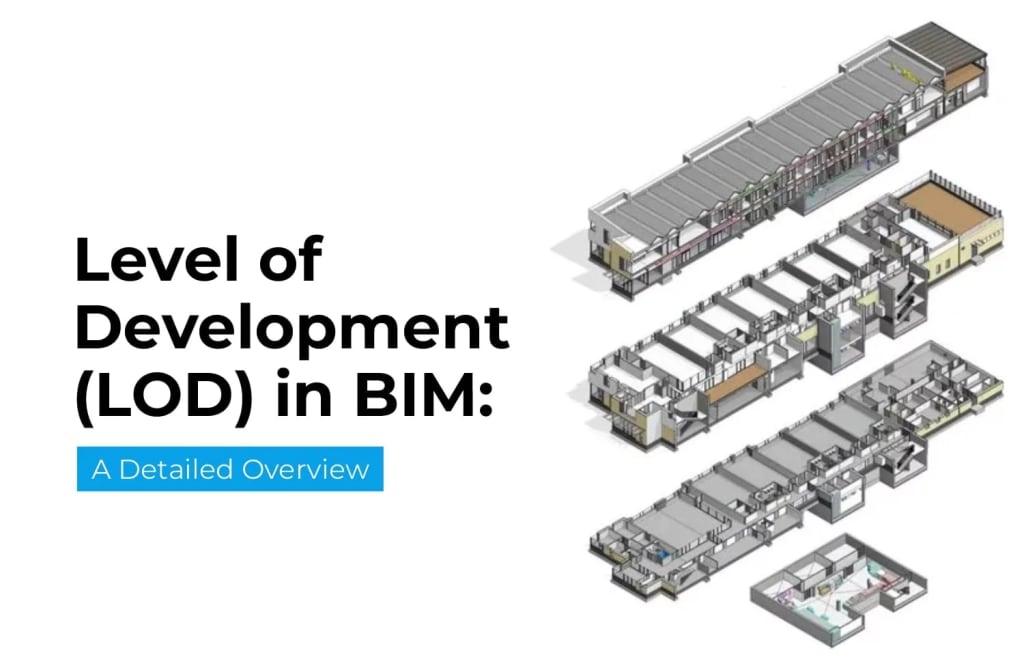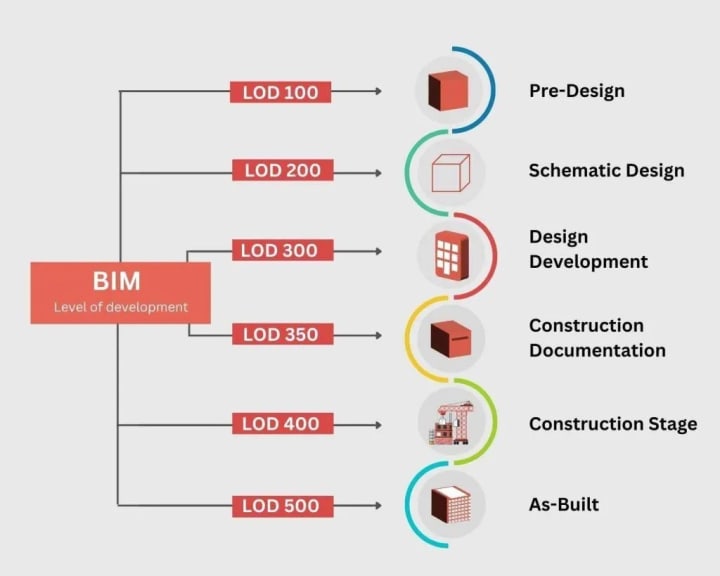Level of Developement (LOD) in Construction Projects
Understanding in this article, we will delve into what LOD is why crucial in the construction industry?

In the ever-evolving world of construction and architecture, the need for precise and standardized information has never been more critical. This is where the concept of Levels of Development (LOD) comes into play.
LOD provides a structured framework for defining the level of detail and accuracy required for building information modeling (BIM) in various stages of a construction project.
In this article, we will delve into what LOD is, why it is crucial in the construction industry, and how it is employed.
What is LOD?
Levels of Development, often referred to as LOD, is a system used in the construction and architecture industries to specify and understand the level of detail and accuracy of a Building Information Model (BIM) at different stages of a project.
Essentially, LOD defines how much information is available about a building or infrastructure project and to what degree that information can be relied upon.
Also Read: Difference Between LOD 300 and LOD 350
In simpler terms, LOD acts as a scale that helps stakeholders in a construction project to assess the completeness and reliability of the data within a BIM model.
It allows everyone involved to understand the extent to which the project has been developed, helping in making informed decisions and avoiding misunderstandings or errors.
Why is LOD Important?
LOD serves as a crucial communication tool within the construction industry. Its importance lies in its ability to ensure that all parties involved in a project, from architects and engineers to contractors and owners, have a shared understanding of the project's progress and requirements.
Here are some key reasons why LOD is vital:
Clarity and Consistency: LOD provides a common language and framework for discussing the level of detail in a BIM model. This ensures that everyone involved in the project is on the same page, reducing misinterpretations and discrepancies.
Risk Mitigation: Inaccurate or incomplete information in the early stages of a project can lead to costly changes and delays later on. LOD helps in identifying gaps or inconsistencies early, allowing for timely corrections and risk mitigation.
Efficiency: LOD allows project teams to allocate resources more efficiently by specifying the level of detail needed at each stage. This prevents overinvestment in unnecessary details or underdevelopment of critical aspects.
Cost Control: With LOD, project owners can have better control over their budget by understanding the cost implications of different levels of development. They can allocate funds where they are most needed and avoid unexpected expenses.
Quality Assurance: LOD standards promote best practices and quality control in BIM modeling. This ensures that BIM models are accurate and reliable, reducing errors during construction and improving the final product's quality.
You may would like to read -
How is LOD Used?
LOD is applied throughout the lifecycle of a construction project, from its initial conception to the final as-built stage. It serves as a guideline for determining the level of detail required for various project-related tasks.
Let's explore how LOD is used at different project stages:

LOD Levels
LOD is typically categorized into different levels, each representing a specific stage of development and detail. The American Institute of Architects (AIA) and the Building Owners and Managers Institute International (BOMA) have outlined LOD standards that are widely adopted in the industry. Below are the common LOD levels:
LOD 100: Conceptual
LOD 100 is the most basic level and is used in the early stages of a project. It provides a rough representation of the building's massing, location, and orientation.
Purpose: LOD 100 helps stakeholders understand the overall concept and layout of the project. It is often used for initial design discussions and feasibility studies.
LOD 200: Approximate Geometry
LOD 200 represents a more detailed stage where approximate shapes and sizes of building components are defined. It includes basic 3D representations.
Purpose: LOD 200 is used for early design development and spatial coordination. It helps in assessing the size and arrangement of building elements.
LOD 300: Preliminary
LOD 300 provides a higher level of detail, including precise dimensions and location of building elements. It allows for more accurate cost estimation.
Purpose: LOD 300 is employed during the detailed design phase, where specific materials and systems are chosen. It aids in quantity takeoffs and cost planning.
LOD 350: Detailed
LOD 350 adds further detail by including fabrication-level information for individual building components. It specifies how the elements are assembled.
Purpose: LOD 350 is essential for coordination between different trades and for manufacturing or fabrication purposes. It ensures precise construction and assembly.
LOD 400: Fabrication and Assembly
LOD 400 focuses on the fabrication and assembly of building components, providing information on connections, tolerances, and specific materials.
Purpose: LOD 400 is used by manufacturers and contractors to create detailed shop drawings and assemble components accurately.
LOD 500: As-Built
LOD 500 represents the final stage, where the BIM model reflects the as-built conditions of the project. It includes precise measurements and details.
Purpose: LOD 500 is used for facility management, maintenance, and renovation purposes. It provides an accurate representation of the completed building.
Also Read: BIM Integrated As-Built Drawings for Building Construction Management
Factors Affecting LOD
The choice of LOD for a specific project is influenced by several factors, including:
Project Type
The nature of the construction project plays a significant role in determining the appropriate LOD. For example, a small residential building may not require the same level of detail as a complex commercial or industrial facility.
Project Budget
Budget constraints can impact the LOD chosen for a project. Higher levels of detail often require more time and resources, which can drive up costs. Project owners must strike a balance between their budget and the desired level of information.
Project Schedule
The project timeline can also dictate the LOD. Tight schedules may necessitate using lower LODs in the early stages to expedite design and planning, with higher LODs employed as the project progresses.
Project Requirements
Specific project requirements, such as sustainability goals, regulatory compliance, or complex structural elements, can influence LOD decisions. Projects with unique challenges may require higher levels of detail to address these complexities adequately.
Conclusion
Levels of Development (LOD) are a critical component of modern construction projects. They provide a structured framework for specifying the level of detail and accuracy required at different stages of a project, ensuring clear communication, risk mitigation, and efficient resource allocation.
Understanding the various LOD levels and the factors that influence their selection is essential for successful project management in the construction industry. As technology and industry standards continue to evolve, LOD remains a valuable tool for achieving better outcomes in construction and architecture projects.
About the Creator
Matt Sharon
A professional content writer. Having years of experience in Technology, health, finance, and construction and real estate field. Writing is my passion and I love to play with words Confidently.






Comments
There are no comments for this story
Be the first to respond and start the conversation.